



Left: Maria Grazia Chiuri and Pierpaolo Piccioli for Valentino. Evening dress, spring/summer 2014 haute couture. Courtesy of Valentino S.p.A. . Right: . Middle left: Christian Lacroix. Wedding ensemble, autumn/winter 2009–10 haute couture. Courtesy of Maison Christian Lacroix, Paris. Middle right: Domenico Dolce and Stefano Gabbana for Dolce & Gabbana. Wedding ensemble, spring/summer 2013 alta moda. Courtesy of Dolce & Gabbana. Right: Yves Saint Laurent. Statuary vestment for the Virgin of El Rocío, ca. 1985. Courtesy of Chapelle Notre-Dame de Compassion, Paris. Unless otherwise stated, all images were created from digital composite scans by Katerina Jebb [Click on images to enlarge them.]

f irony means saying one thing and meaning another, the Heavenly Bodies show at the Metropolitan Museum of Art both embodies multiple forms of irony and yet at a key point oddly enough suffers from an obvious lack of an unwillingness to recognize, or at least admit, the central irony of the show — the way famous fashion designers employ dress of Roman Catholic priests and nuns, some in orders devoted to poverty, for lavish garb that dismissively mocks the gospel pronouncement that it's easier for a camel to get through the eye of a needle than for a rich man to enter heaven. Of course, as the show's chat labels admit at a few points, satire of such wealth of the Catholic Church and its wealthy believers had been done brilliantly by Fellini's 1972 film Roma, which presents the excesses of the church as an elaborate runway fashion show, one of the last parts of which took the form of a series of empty copes and bishop’s mitres. In fact, Heavenly Bodies turns out to be a lavishly funded footnote to Fellini’s film, the relevant portion of which visitors can watch on a video display decorously placed against a wall where, one immediately notices, very few of those who attend the exhibition ever see it.
All that missing social, religious, and political criticism does not of course mean that Diller Scofidio + Rnfro, the exhibition designers, did not do a brilliant job of placing the individual exhibits, which range from a row of women's wear based on the priest's soutane, or long gown, to another incorporating parts of the habits warn by nuns to, finally, wedding dresses almost identical in feeling and detail to those that clothe Mary of the Immaculate Conception as Queen of Heaven.


Fashion designers used the priestly soutane and noun’s habits for inspiration. Photographs courtesy of the Metropolitan Museum of Art. [Click on these and following images to enlarge them.]
Entering from the museum’s main entrance and proceeding through the Great Hall, one passes by a security guard acting as a gatekeeper who directs one to the corridor to the right of the Met’s main stairway, where high above one’s heads stand a row of dresses whose decorations remind one of the early Christian mosaics in Ravenna (immediately below).


Left: Domenico Dolce and Stefano Gabbana for Dolce & Gabbana. Ensemble, autumn/winter 2013–14. Courtesy of Dolce & Gabbana.. Right: A view of the mosaic dresses at the beginning of the exhibition. (I have darkened the photograph taken from the Met site to produce the atmosphere in which one actually sees the line of dresses.) [Click on images to enlarge them.]
Rather than place these golden dresses in glass or plexiglas cases, the designer has rather brilliantly chosen to raise them above the crowd and the byzantine objects in cases along the corridor. The dresses look so heavy that wearing them might be uncomfortable, but we know immediately that we have found ourselves in a strange unearthly place where practicality, affordability, even simple wearability have no place. This is, after all, the the world of high fashion.




Left: Sorry, I didn’t photograph this work’s caption. Middle left: “Madonna” wedding ensemble. John Galliano for House of Dior. 2005-6. According to the exhibition label, this piece was “inspired by the Cuzco School, a Roman Catholic artistic tradition based on Cuzco, Peru, during the sixteen through eighteenth centuries.” Middle right: Two evening dresses designed by Kate and Laura Mulleavy for Rodarte. 2011. Both parody the monstrance that displays a consecrated host (communion wafer) on the altar. Right: The “Gold-Gotha” Ensemble by Maison Christian Lacroix, 1988-89. These four photos by the reviewer.
Thinking over the show from the vantage of the Victorians, two authors immediately come to mind — Oscar Wilde and his near opposite, Thomas Carlyle. Wilde because his his quip “Nothing succeeds like excess” in so many ways characterizes the entire show. Thomas Carlyle because of his criticism of Holman Hunt’s The Light of the World when he asked the artist, “Do you ever suppose that Jesus walked about bedizened in priestly robes and a crown, and with yon jewels on his breast, and a gilt aureole round His head? . . . Well — and if you mean to represent Him as the spiritual Christ, you have chosen the form in which He has been travestied from the beginning by worldlings who have recorded their own ambitions as His, repeating Judas’ betrayal to the high priests” (Pre-Raphaelitism and the Pre-Raphaelite Brotherhood, I, 355). Carlyle of course spoke from the vantage point of a Scottish Presbyterian, a true descendent of seventeenth-century Puritans, but an exhibition with Fellini in the corner and a dress in a style that its designer termed “Fetish Nun” needs at some point to confront the the implications the objects it so lavishly displays. Taken as a whole, Heavenly Bodies exemplifies the decadent aesthetic, “decadent” here indicating a stylistic rather than moral category, since like both art and literature of the Decadence, it uses well established symbols and representative details for an effect, for a frisson, and definitely not to convey their original meanings.



Left: Chasuble (back) of Pius XI (r. 1922–39), 1926. French. Courtesy of the Collection of the Office of Liturgical Celebrations of the Supreme Pontiff, Papal Sacristy, Vatican City. Middle: Cope of Benedict XV (r. 1914–22), 1918. Italian. Courtesy of the Collection of the Office of Liturgical Celebrations of the Supreme Pontiff, Papal Sacristy, Vatican City. Right: Mitre of Pius XI (r. 1922–39), 1929. Italian. Courtesy of the Collection of the Office of Liturgical Celebrations of the Supreme Pontiff, Papal Sacristy, Vatican City. [Click on images to enlarge them.]
Taking the long walk to the Vatican treasures that form the second, much smaller though vastly more valuable (in earthly, monetary terms) part of the exhibit, one encounters chasubles, copes, triple-crowned diamond-encrusted papal tiaras and rings. I found myself surprised by how different was the effect of this part of Heavenly Bodies in the Anna Wintour Costume Center, which displays garments covered with real gold and real jewels. As both of my companions, one of them a designer, remarked, “This is really dull and boring,” and yes, it certain was, though hardly for lack of expenditure. I've seen these galleries used for several shows, including Death Becomes Her: A Century of Mourning Attire, which despite its subject — Victorian and Edwardian clothing worn by those (including Queen Victoria) who'd lost a loved one — the exhibition never created this impression.



Left: Dalmatic (front) of Pius IX (r. 1846–78), 1845–61. Italian. Courtesy of the Collection of the Office of Liturgical Celebrations of the Supreme Pontiff, Papal Sacristy, Vatican City. Middle: Cope of Benedict XV (r. 1914–22), 1918. Italian. Courtesy of the Collection of the Office of Liturgical Celebrations of the Supreme Pontiff, Papal Sacristy, Vatican City.. Right: Loredano Apolloni (Italian, 1957–2016). Shoes of John Paul II (r. 1978–2005), ca. 2000–5. Courtesy of the Collection of the Office of Liturgical Celebrations of the Supreme Pontiff, Papal Sacristy, Vatican City. D. [Click on images to enlarge them.]
Certainly the most bizarre and least successful part of Heavenly Bodies is the two-volume catalogue whose heavy, ugly typeface suggests that the organizers ran out of money and couldn't afford a designer. The second problem with the catalogue appears in the pages devoted to illustrations of the objects. If the visitors to the show thought that neo-byzantine dresses suspended high above their heads, a design for displaying the consecrated host used to reveal a woman’s bare belly, and a wedding dress with fairy wings that lurched into bizarre self-parody, they should wait until they pick up the catalogue and encounter most of the images (one can't call then reproductions) doubly distorted. First of all, looking like the work of someone who's just discovered PhotoShop or GIMP filters, each image appears as a mosaic of large squares. Worse, many of the images appear grotesquely elongated, suggesting that the person or persons who put together the catalogue — one honestly can't write designed it — didn't believe that representing the objects accurately was the role of an exhibition catalogue.




Left: Cristóbal Balenciaga for House of Balenciaga. Wedding ensemble, 1967. Courtesy of Balenciaga Archives. Middle left: Jean Paul Gaultier. "Lumière" evening ensemble, spring/summer 2007 haute couture. Courtesy of Röhsska Museum, Sweden. Middle right: Madame Grès (Alix Barton). Evening dress, 1969. The Metropolitan Museum of Art, New York, Brooklyn Museum Costume Collection at The Metropolitan Museum of Art, Gift of the Brooklyn Museum, 2009; Gift of Mrs. William Randolph Hearst, Jr., 1988 (2009.300.1373). Right: Elsa Schiaparelli. Evening dress, summer 1939. The Metropolitan Museum of Art, New York, Brooklyn Museum Costume Collection at The Metropolitan Museum of Art, Gift of the Brooklyn Museum, 2009; Gift of Arturo and Paul Peralta-Ramos, 1954 (2009.300.1185a, b).
Heavenly Bodies: Fashion and the Catholic Imagination, only the latest in a series of recent exhibitions devoted to fashions created for the very, very rich, provides a plethora of visual delights that have much to tell us about the the state of so many things in our culture. Upon observing the degree to which the organizers obviously genuflect with far more reverence to the Balenciagas, Gaultiers, and Schiaparellis than either to the religion to which these objects pay parodic homage or to the medieval religious art that surrounds them, one realizes that Fellini was not exaggerating all that much.
Created 3 July 2018